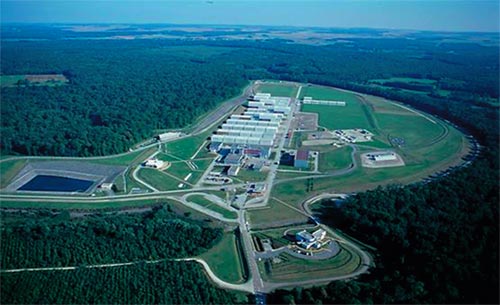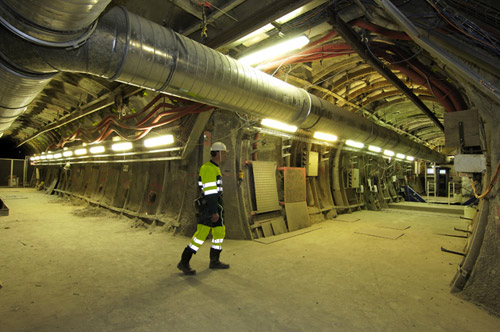Repositories already in operation for low-level waste

Aube waste repository (CSA)
In France, low and intermediate-level short-lived waste is disposed of at the CSA repository (Centre de Stockage de l’Aube). Very low-level waste is sent to another large operational facility located nearby, in Morvilliers. The CSA repository has taken over from the CSM facility, which is now full and has entered its monitoring phase. Waste is disposed at ground level at these three facilities, unlike high-level waste, which will be disposed of deep underground.
© ANDRA
Compared with other types of waste, the mass of radioactive waste is tiny, representing around 2 kilograms per person per year in France; only 20 grams of this is high-level waste, of which 1 gram of long-lived elements. These few grams pale in comparison to the 360 kg of household waste, 2.5 tonnes of industrial waste and 6.5 tonnes of carbon dioxide released into the atmosphere per capita.
Clearly, however, the problems associated with the management of radioactive waste are of another order of magnitude. Management strategies vary according to the level of radioactivity.
The intended solution for the most radioactive waste (long-lived intermediate- and high-level waste) is to dispose of it deep underground. High-level waste releases heat and is currently kept in interim storage, allowing it to cool. Paradoxically, there is little urgency regarding the ultimate management of this category of waste. It can be held in interim storage until a suitable disposal site is found. Interim storage is necessary while the requisite licenses are obtained and the repository facilities are built.
In France, the first vitrified waste packages are scheduled to be sent to the CIGEO geological repository in 2025. A site near Bure en Lorraine, on the boundary between the Meuse and Haute-Marne departments, has been identified. This huge underground facility, for which must parliamentary approval must be obtained, among other licenses, would operate for around 100 years.
Apart from the WIPP military waste repository in the United States, no deep geological repositories have yet been built. The Yucca Mountain project in Nevada, where high-level waste would have been disposed of, was cancelled by the Obama administration in 2010. In France, research into the properties of clay layers continues at the underground laboratory in Bure, pending construction of CIGEO.

Bure underground laboratory
The underground laboratory in Bure, on the boundary between the Meuse and Haute Marne departments features surface facilities extending over approximately 17 hectares as well as 1 kilometre of underground installations excavated directly into the Callovo-Oxfordian clay formation, 445 and 490 metres underground. These deep-lying clay layers in the Paris Basin are impermeable and very stable, making them candidates for disposal of long-lived high-level waste with effect from around 2020.
© ANDRA
Management of lower-level radioactive waste (2 kilograms per capita) is the least problematic. Appropriate precautions must be taken, owing to the radioactivity, but the corresponding solutions are relatively simple to implement. Waste is conditioned according to its activity level using conventional means, and is then disposed of above ground. Repositories exist in France and other countries. There are three in France, one of which has been completely filled and is now in the monitoring phase.
Low- and intermediate-level short-lived waste (LILW-SL) and very low-level waste (VLLW) are the two least radioactive categories. These two categories account for approximately 90% of radioactive waste by volume. An operational disposal solution already exists, at the CSA facility in the Aube department (for low- and intermediate-level short-lived waste) and at the CIRES facility in Morvilliers (for very low-level waste).
The waste’s radioactivity decays naturally, gradually falling to a level similar to natural background radioactivity. In the case of very low-level waste, as its name suggests, the initial radioactivity level is very low. With « low- and intermediate-level short-lived waste », the initial activity is higher, but radioactivity decays to an acceptable level relatively rapidly.
France’s radioactive waste agency – Agence Nationale des Déchets Radioactifs (ANDRA) -is responsible for managing such waste and establishing appropriate disposal processes. ANDRA ensures that low-level waste from sources such as nuclear power plants, hospitals, factories and research laboratories is disposed of and monitored in accordance with safety guidelines. The agency’s mission also includes designing and building repositories for waste not accepted by existing facilities.
Learn more :
Early waste disposals
High-level waste (HLW)
Intermediate-level waste (ILW-LL)
Low- and intermediate-level waste
Area 2: Disposal
The CIGEO project for HLW waste in France
Other articles on the subject « Waste management »
Other storage facilities
Interim waste storage according to their nature and origin Spent fuel and vitrified waste from Pr[...]
Temporary storage
A temporary solution Interim storage is a temporary solution that plays a central role in the man[...]
Vitrified waste Storage
Dry storage of vitrified waste Spent nuclear fuel assemblies are not the only materials removed f[...]
Spent fuel storage
Interim storage in pools and then dry locations In all countries, spent fuel management begins wi[...]
Management outside France
Overview of waste management strategies outside France Management of the least radioactive waste [...]
LILW-SL waste repository
Disposal of low and intermediate-level short-lived waste Low and intermediate-level short-lived w[...]
VLLW repository
An operational repository for very low-level waste The second category of waste for which a repos[...]
High level waste transportation
Moving highly radioactive materials The 10% of transport movements that concern high-level radioa[...]
Transport safety
Measures to ensure safe transport Nuclear materials may be highly radioactive. The goal is to pre[...]
Transport-related incidents
Incidents but no accidents… Have radioactive material transport operations caused any accid[...]